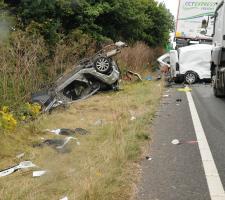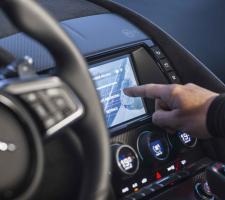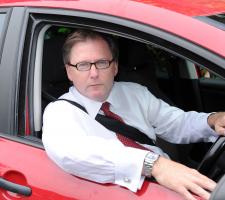
Jaguar Land Rover has been called ‘irresponsible’ after an article described drivers using in-built technology to check their calendars and use other apps while on the road
With the UK set to increase the penalties for using mobile phones while driving, the RAC Foundation’s Steve Gooding considers what else can be done to combat this deadly distraction.
The first mobile phone call was made in 1973, by an engineer working for Motorola. Today 4.7 billion people across the globe subscribe to a mobile service. In the UK alone, at least two-thirds of the population now have a smartphone. The first car was, arguably, made by Carl Benz in the 1880s. Now there are well over a billion on the planet.
Individually they have both contributed greatly to global connectivity, accessibility and opportunity. However, together – and it was inevitable that the twain should meet – there are complications.
Mobile phone technology potentially offers drivers great advantages: from providing directions, to giving traffic information, to facilitating the payment of tolls and parking charges. And yet the use of mobiles in vehicles also offers up the possibility of disaster. Hence why the law is explicit: It’s illegal to use a hand-held phone or similar device while driving, or riding a motorcycle. The rules are the same if you’re stopped at traffic lights or queuing in traffic.
It couldn’t be much clearer, and yet some people are still tempted to take their hands off the wheel to use their phone, sometimes with tragic consequences. In Great Britain (which has the fourth safest roads in the world according to the WHO), in 2015 a driver using a mobile phone was a contributory factor in 22 fatal accidents – and that was probably an underestimate.
While there might be records to prove a driver was making a call at the time of an accident it is much harder to demonstrate whether they were scrolling through messages, looking at Facebook, checking e-mail, or composing a lengthy text at the time of a catastrophic collision. And a driver is unlikely to admit to such an action.
In most countries around the world it is illegal to use a hand-held mobile at the wheel - in the UK it became an offence in December 2003. Since then, and in response to continuing evidence of noncompliance, the penalties for doing so have increased three times, including this year, with punishment now standing at a £200 fixed penalty and six points on a licence (12 points usually results in the driver having their licence withdrawn for a period).
Naturally all those involved hope that the new penalties will make more people stop and think, but will it be enough, particularly given the low likelihood of actually being caught?
So the next question we asked was whether technology could help drivers do the right thing. We are all familiar with flight mode on our mobile phones, so why not drive-safe mode, installed as standard? Or possibly, and this is debatable, could the technology take over and deliver compliance automatically?
Ministers in the UK are keen to explore all avenues and are reportedly meeting with representatives of the telecoms industry to discuss the options. This is a meeting and approach the4961 RAC Foundation warmly endorses. In fact, it is a route we ourselves followed last year when we commissioned TRL (formerly the Transport Research Laboratory) to speak to telecoms companies, vehicle manufacturers and phone makers to find out what they were doing to limit the use of potentially distracting technology.
The results were not universally encouraging. Because the responses revealed that, in general terms, while a great deal of thought goes into the design of built-in equipment and dashboard layout, when it comes to products not specifically designed for in-car use:
1) ‘distraction in vehicle’ was not consistently considered to be a priority during the design phase;
2) it was largely thought to be up to the driver to make sure their use of technology in the car complied with the law;
3) in the absence of any legal obligation, few companies would incorporate limitations on the use of their equipment because they felt that would put them at a commercial disadvantage; however,
4) demands for technologies such as drivesafe mode could come from fleet and safety managers, because they are more directly aware of the legal and moral duty to protect their employees and the public.
So the demand could be there. How hard would it be?
We know that the data generated by a smartphone can be used to identify whether it is travelling in a car or a train, and deduce how fast it has been travelling. It doesn’t look to be beyond the grasp of clever designers to create an automatic app.
Indeed, it appears that as far back as 2008 a US patent application assigned to493 Apple was filed (and eventually granted) for a so-called lock-out mechanism which could – in one incarnation – curb functionality because the device is in a car. It would use motion sensors to detect if the device was travelling at above a preset speed and then use scenery analysers to determine if the ‘hand-held computing device is located within a safe operating area of a vehicle based on at least one of picture data and video data.’
As far as I am aware this technology has not been applied commercially. What’s more, the existence of a patent is likely to limit the ability of another company to develop and bring to market a similar product.
It might be that Apple relents and follows the example of609 Volvo from decades earlier. The Swedish company patented the now-ubiquitous three-point safety belt but recognising the social benefits made the design available to others without demanding a fee.
But there are two more design challenges to be tackled. The first, obviously, is that the phone might be carried by a passenger in the vehicle – a business executive taking an important call wouldn’t thank their phone for cutting out mid-deal. So maybe automated cut-out isn’t feasible. What about a car-safe mode that needs to be activated? The challenge then is to ensure that the right functions are disabled whilst leaving others ‘live’, such as satnavs. It sounds doable to me.
The first thing that should go is surely the ability to read and send texts. Previous work by the RAC Foundation showed that texting whilst driving impaired a driver more than if they were at the legal drink-drive limit. This is not entirely surprising, given that at 96km/h (60mph) even a second-long glance down at a screen will mean almost 30m (98ft) covered without attention to the road. Perhaps when the mobile phone issue first came to the lawmakers’ attention that they had in mind the vision of a motorist with a phone clamped to their ear chattering away. How much worse the sight of someone focused on the phone screen rather than looking ahead through the windscreen?
Which leads to our second concern. While the focus on the hand-held mobile is perfectly logical, we can’t help but question the wisdom of the increasingly widespread installation of dashboard touchscreens.
Of course auto designers are keen to give motorists the best at-a-glance information, as well as state-of-the-art audio systems. But touchscreens aren’t tactile – drivers have to look at what the screen is displaying.
Centrally mounted screens necessarily mean eyes off the road. And some require multiple ‘touches’ to scroll through screens, all of which takes time and attention.
So there’s still work to be done to ensure our in-car systems are designed to help drivers focus on the road and not be distracted by the dashboard. Unless and until, of course, the autonomous car literally makes the whole issue of driver distraction a thing of the past.
The first mobile phone call was made in 1973, by an engineer working for Motorola. Today 4.7 billion people across the globe subscribe to a mobile service. In the UK alone, at least two-thirds of the population now have a smartphone. The first car was, arguably, made by Carl Benz in the 1880s. Now there are well over a billion on the planet.
Individually they have both contributed greatly to global connectivity, accessibility and opportunity. However, together – and it was inevitable that the twain should meet – there are complications.
Mobile phone technology potentially offers drivers great advantages: from providing directions, to giving traffic information, to facilitating the payment of tolls and parking charges. And yet the use of mobiles in vehicles also offers up the possibility of disaster. Hence why the law is explicit: It’s illegal to use a hand-held phone or similar device while driving, or riding a motorcycle. The rules are the same if you’re stopped at traffic lights or queuing in traffic.
It couldn’t be much clearer, and yet some people are still tempted to take their hands off the wheel to use their phone, sometimes with tragic consequences. In Great Britain (which has the fourth safest roads in the world according to the WHO), in 2015 a driver using a mobile phone was a contributory factor in 22 fatal accidents – and that was probably an underestimate.
While there might be records to prove a driver was making a call at the time of an accident it is much harder to demonstrate whether they were scrolling through messages, looking at Facebook, checking e-mail, or composing a lengthy text at the time of a catastrophic collision. And a driver is unlikely to admit to such an action.
In most countries around the world it is illegal to use a hand-held mobile at the wheel - in the UK it became an offence in December 2003. Since then, and in response to continuing evidence of noncompliance, the penalties for doing so have increased three times, including this year, with punishment now standing at a £200 fixed penalty and six points on a licence (12 points usually results in the driver having their licence withdrawn for a period).
Naturally all those involved hope that the new penalties will make more people stop and think, but will it be enough, particularly given the low likelihood of actually being caught?
So the next question we asked was whether technology could help drivers do the right thing. We are all familiar with flight mode on our mobile phones, so why not drive-safe mode, installed as standard? Or possibly, and this is debatable, could the technology take over and deliver compliance automatically?
Ministers in the UK are keen to explore all avenues and are reportedly meeting with representatives of the telecoms industry to discuss the options. This is a meeting and approach the
The results were not universally encouraging. Because the responses revealed that, in general terms, while a great deal of thought goes into the design of built-in equipment and dashboard layout, when it comes to products not specifically designed for in-car use:
1) ‘distraction in vehicle’ was not consistently considered to be a priority during the design phase;
2) it was largely thought to be up to the driver to make sure their use of technology in the car complied with the law;
3) in the absence of any legal obligation, few companies would incorporate limitations on the use of their equipment because they felt that would put them at a commercial disadvantage; however,
4) demands for technologies such as drivesafe mode could come from fleet and safety managers, because they are more directly aware of the legal and moral duty to protect their employees and the public.
So the demand could be there. How hard would it be?
We know that the data generated by a smartphone can be used to identify whether it is travelling in a car or a train, and deduce how fast it has been travelling. It doesn’t look to be beyond the grasp of clever designers to create an automatic app.
Indeed, it appears that as far back as 2008 a US patent application assigned to
As far as I am aware this technology has not been applied commercially. What’s more, the existence of a patent is likely to limit the ability of another company to develop and bring to market a similar product.
It might be that Apple relents and follows the example of
But there are two more design challenges to be tackled. The first, obviously, is that the phone might be carried by a passenger in the vehicle – a business executive taking an important call wouldn’t thank their phone for cutting out mid-deal. So maybe automated cut-out isn’t feasible. What about a car-safe mode that needs to be activated? The challenge then is to ensure that the right functions are disabled whilst leaving others ‘live’, such as satnavs. It sounds doable to me.
The first thing that should go is surely the ability to read and send texts. Previous work by the RAC Foundation showed that texting whilst driving impaired a driver more than if they were at the legal drink-drive limit. This is not entirely surprising, given that at 96km/h (60mph) even a second-long glance down at a screen will mean almost 30m (98ft) covered without attention to the road. Perhaps when the mobile phone issue first came to the lawmakers’ attention that they had in mind the vision of a motorist with a phone clamped to their ear chattering away. How much worse the sight of someone focused on the phone screen rather than looking ahead through the windscreen?
Which leads to our second concern. While the focus on the hand-held mobile is perfectly logical, we can’t help but question the wisdom of the increasingly widespread installation of dashboard touchscreens.
Of course auto designers are keen to give motorists the best at-a-glance information, as well as state-of-the-art audio systems. But touchscreens aren’t tactile – drivers have to look at what the screen is displaying.
Centrally mounted screens necessarily mean eyes off the road. And some require multiple ‘touches’ to scroll through screens, all of which takes time and attention.
So there’s still work to be done to ensure our in-car systems are designed to help drivers focus on the road and not be distracted by the dashboard. Unless and until, of course, the autonomous car literally makes the whole issue of driver distraction a thing of the past.
ABOUT THE AUTHOR: Steve Gooding is director of the Royal Automobile Club Foundation for Motoring, an independent charitable transport policy and research organisation which explores the economic, mobility, safety and environmental issues relating to roads.














